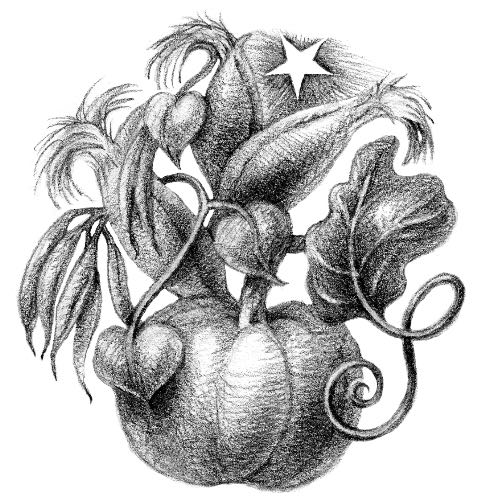Through the Garden Gate—February 2016
February, Time Travel
By Leslie Watkins

“Three Sisters” © Leslie Watkins 2016
What if you could travel through time, predict the future and divine meteorological events? And what if by doing so you could create food, clothing, shelter and a less stressful existence–an existence that would afford you more time to enjoy leisure activities, have deeper relationships with loved ones and experience greater personal development?
You can, and humans have been doing it since the dawn of civilization. By watching the stars and recording astral movements, people created calendars. Calendars record the dates important to growers and help us plan for the future. We can predict seasonal variations, forecast weather patterns and anticipate frost dates. By envisioning what we would like on our dinner plates, we put into action the steps needed to ensure our future health and pleasure.
Calendars are based on the number of days it takes the earth to orbit the sun, 365.242, and on the earth’s moon cycle, 29.531 days. The ancient Babylonian calendar was based on the moon, as are the Jewish and Arabic calendars. The ancient Egyptian calendar was based on the sun, with an average of 365.25 days in a year. The Egyptian calendar was adopted in Rome around 45 BC. It replaced the 10-month Roman calendar and became known as the Julian calendar after Julius Caesar. By the 1500s the Julian calendar was out of sync with the seasons by 10 days. It was modified in 1582 in the reign of Pope Gregory XIII to reflect 365.2425 days in a year. The resulting Gregorian calendar is now known as the Common calendar and is used around the world. The names of the months are still based on Latin names words.
So, what does this mean to us? Getting seeds planted at the right time is of utmost importance. Our survival depends on it. And what about cultures without calendars? Close observations of nature provide the necessary cues. Indian lore tells us that the time to plant corn is when oak leaves are the size of mouse ears. Arriving on the shores of Cape Cod in 1620 after a harrowing voyage, the Pilgrims could not have survived without help from the Wampanoag people. The Europeans came to an agreement with the Wampanoag that Tisquantum (Squanto), a member of the Patuxet tribe, would stay with the Pilgrims over the winter and help them get their first spring planting done. It was the Wampanoag seed stores, food reserves and knowledge that made it possible for the settlers to make it through that dreadful first winter. The Wampanoag knew when to get seeds into the ground to allow enough time for ripening. They were careful to save the best seeds and to store them safely for the next year.
If you would like to grow some of the plants the indigenous people of New England grew, try Connecticut field pumpkins, flint corn and cranberry, white or kidney beans. These staples, known collectively as the Three Sisters, provide the basis for a nutritious diet. They grow well here, have relatively few pests or diseases, store for a long time and produce seeds that are easy to save.
With our limited growing season it is important to pay attention to dates. Seeds planted too early may be killed by frost; those planted too late won’t fully mature. Traditionally, our last frost date is Memorial Day, and our first frost date is after mid-September. Keeping records can help you be a better gardener. Start a garden journal and travel in time.
February Journal Checklist
Map out your vegetable garden design.
Note past successes and failures.
List new varieties to try out.
Assign dates to start and plant out seeds.
Note seed planting depths and distances.
Figure out a plant family rotation schedule.
Learn about companion planting.
Plan on succession planting and schedule dates.
Swap seeds with gardening friends for added diversity.
Get your seeds ordered!
Illustration: “Three Sisters” by Leslie Watkins © 2015
